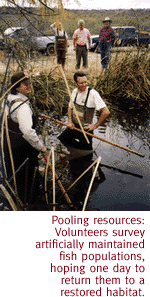
In The Middle Of The Desert, It's Still Possible To Net A Few.
By Kevin Franklin
THE DESERT ENVIRONMENT can be a tough place to eke out
a living, especially if you're a fish.
In the San Bernardino National Wildlife Refuge in the far southeastern
corner of the state, a few native fish survive in 10 man-maintained
ponds. The U.S. Fish and Wildlife Service preserves these populations
in the hope that, one day, riparian areas in the neighboring drainages
will be able to maintain wild populations of desert fish.
 A few volunteers from the Arizona League of Conservation Voters
Habitat Fund have come out to lend a hand to the Fish and Wildlife
Service in an surveying the fish population.
A few volunteers from the Arizona League of Conservation Voters
Habitat Fund have come out to lend a hand to the Fish and Wildlife
Service in an surveying the fish population.
The basic idea involves a seining net: A thin mesh net about
10 feet long and four feet high is held down on the bottom by
small weights and tied on each end to a pole. Operated by two
people, the poles are pulled along in shallow water just like
a hand-held version of a fishing trawler net.
Today we're trying to drag our seines through the ponds and count
the number and diversity of fish we catch--and then return them
unharmed to their pool. With this information Fish and Wildlife
Service biologist Tony Velasco can keep tabs on what's happening
to his gilled charges. Yaqui top minnows, Yaqui chubs and Yaqui
catfish are all endemic to San Bernardino. The beautiful shiner
fish also lives here. Since the entire staff at San Bernardino
can be counted on one hand, it's difficult for Velasco to find
anyone with free time to help with the survey. This is where we
step in.
Velasco provides a quick lesson in operating a seining net. Struggling
into waist-high waders, volunteer Luke Evans and I push through
the cattails lining the bank to the murky depths of one of the
pools. The waders keeps us dry, but the water is ice cold. Pockets
of muck and fallen tree branches do their best to topple us over
into the frigid water.
Luke and I pull up our seine. It's teeming with fish. We set
about counting the different species.
For the most part, the ponds are artificially maintained, but
once the San Bernardino Valley contained an extensive cienega,
or swamp, and perennially flowing streams. Late in the 19th century,
hundreds of thousands of cattle were brought to the area and proceeded
to strip the land of its water-holding vegetation. Then in 1887,
an earthquake struck just south of here in Mexico and shifted
the flow of water in the area. To add insult to injury, a drought
struck that next year, and soon the once-lush valley became a
barren moonscape of erosion and denuded vegetation. Black Draw,
the main drainage in the area that once flowed year-round, cut
deeply into its banks--dropping 12 feet. The Draw stopped flowing
and only a few boggy pools remained.
 Eventually the drought passed and many of the cattle either died
or were removed from the land. The chubs, top minnows, shiners
and catfish struggled along--their numbers dwindling until the
top minnow and chub were listed as endangered and the others were
listed as threatened. Then in 1982, the Fish and Wildlife Service
purchased about 23,000 acres. This became the core of the San
Bernardino Wildlife Refuge.
Eventually the drought passed and many of the cattle either died
or were removed from the land. The chubs, top minnows, shiners
and catfish struggled along--their numbers dwindling until the
top minnow and chub were listed as endangered and the others were
listed as threatened. Then in 1982, the Fish and Wildlife Service
purchased about 23,000 acres. This became the core of the San
Bernardino Wildlife Refuge.
Black Draw is still deeply incised and rarely runs, but the surrounding
habitat is coming back. Refuge personnel are planting native grasses
while neighboring cattle ranches are adopting progressive ranching
techniques which allow the land to recover. One day Velasco hopes
Black Draw will run again.
"The healing is going to come in with the rest of the valley,"
Velasco says. "If in 30 years when this stream heals up and
isn't incut by 12 feet, maybe just six feet, and we get a perennial
flow again, then maybe we can reintroduce the fish to natural
habitat. It's going to be a lifetime project. If I can get the
same kind of satisfaction from this as those folks did releasing
the California Condor, then it will all be worth it."
Getting There
The San Bernardino Wildlife Refuge is just east of Douglas.
Call (520) 364-2104 to get a free permit to enter the otherwise
locked refuge. The Arizona League of Conservation Voters
is always looking for volunteers. Call them at 622-2819
to find out more.

|





